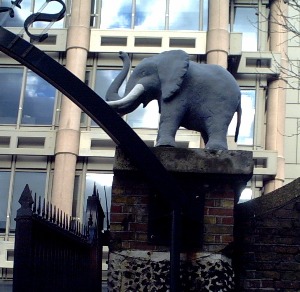
LONDON ELEPHANTS
|
|
| london-footprints.co.uk |
THE TOWER OF LONDON MENAGERIE
This was set up in 1235 when the Holy Roman Emperor gave Henry
III three leopards. In 1255 an elephant house was added to
accommodate a present from Louis IX of France. The public could
view this animal until its death when it was buried in the Tower
precincts. By 1822 the collection held only a grizzly bear, an
elephant and a couple of birds. Alfred Copps was appointed keeper
and added 59 different species but when a lion attacked members
of the garrison the animals were moved to Regent's Park.
EDWARD CROSS'S MENAGERIE
Exeter Change was built as small shops in 1676 on the site of
Exeter House. In 1773 Edward Cross opened a menagerie which
included lions, tigers, monkeys and an elephant named
Chunee/Chuny imported from Bengal. In a fit of bad temper this 5
ton animal tried to break out of its cage in 1826. Attempts to
shoot it were made by a civilian and then soldiers from Somerset
House. A cannon was sent for but before it arrived a keeper
finished the job with a harpoon. Three days later visitors paid
to see nine butchers spend 12 hours skinning the beast which was
then dissected by 10 surgeons watched by their students. The meat
was taken away and Cross displayed the skeleton with the bullet
holes in the skull still visable. The public's response ranged
from recipes for elephant stew to poems and a play at Sadler's
Wells [more info]. Exeter Change was demolished in 1829
when the remaining animals were taken to the Surrey Zoological
Gardens (see below).
SURREY ZOOLOGICAL GARDENS
This was set up following a meeting in 1831 at the Horns Tavern
in Kennington when Edward Cross arranged to sell his menagerie
and Lord Holland agreed to let a 13 acre site east of Vauxhall
Gardens. The Surrey Gardens offered other attractions besides the
animals for its one shilling admission fee. Queen Victoria and
her family visited in 1848 and it was a popular venue until
eclipsed by the Crystal Palace in 1851. In 1855 the animals were
sold at auction and the proceeds were used to build a new concert
hall. Following a fire this was reconstructed and the building
used by St Thomas's Hospital. The Gardens were sold for
development in 1877 with Penton Place covering part of the site.
There is an open space called Surrey Gardens and Lorrimore Square
has wooden sculptures of some of the animals. [more info]
ZOOLOGICAL GARDENS (LONDON ZOO)
The Zoological Society of London was founded in 1826 and the
following year occupied an area in Regent's Park laid out by
Decimus Burton. The collection was opened to Fellows of the
Society in 1828 and proved a popular attraction. Animals from the
Royal menagerie in Windsor were added in 1830 and from the Tower
(including an Indian elephant) in 1832-4. Two African elephants
Jumbo and Alice arrived in 1867. During WWII a number of animals
were killed although some were evacuated to Ireland. A new
Elephant and Rhino Pavilion was designed by Casson, Condor &
Partners in 1965. [website]
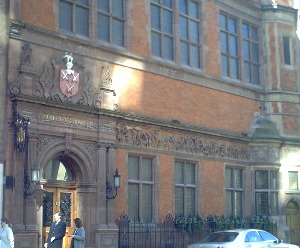 |
THE
CUTLER'S COMPANY This City livery company received their charter in 1416. In the early 17th century the trade was concentrated in Sheffield but surgical instrument making remained in London. The present hall of 1888 in Warwick Lane (pictured) was built on a site previously occupied by the Royal College of Physicians. It was designed by T Taylor Smith with a terracotta frieze by Benjamin Creswick showing cutlers working at their craft. The hall has a hammerbeam roof and the committee room is panelled in Jacobean oak from a house in Yarmouth. There is a panel of 1569 depicting an elephant from the previous hall and wrought iron candelabra. The company coat of arms features an elephant as ivory was used in the making of handles. [website]. |
ELEPHANT & CASTLE
This has been a traffic junction since the 17th century and gets
its name from a tavern, converted from a smithy around 1760. It
became a terminus for coaches and later trams and was a popular
shopping centre with Tarns, Hurlocks & Rabbits. It was badly
bombed in WWII and even more horribly rebuilt in the 1960s.
However over the next ten years the area will be transformed to
provide new homes, shops, leisure activities, transport
connections, office accommodation and five open spaces. The 6'
Elephant & Castle from the pub was relocated outside the
shopping centre. It was due to be removed and broken up but will
now be saved and resited in the new development. [website]
| ELEPHANT
HEADS ON BUILDINGS Left: the former bottling store of the old Camden Brewery (which stood adjacent to it on Horley Crescent) on Kentish Town Road near the canal. "Elephant's Head" Indian pale ale was one of its most popular drinks. Right: South Africa House in the south east of Trafalgar Square. Photos by Matt Salusbury |
| ELEPHANT
PUBS & STREETS The Elephant & Castle which gave its name to the area is the most obvious but there are others including another Elephant & Castle in Holland Street, Kensington, an Elephant Inn in Finchley, The Elephant's Head in Camden and the Elephant in Fenchurch Street. See www.fancyapint.com for reviews of these pubs. There is an Elephant Lane in Rotherhithe. Right:
Elephant's Head pub sign in Chalk Farm Road Camden |
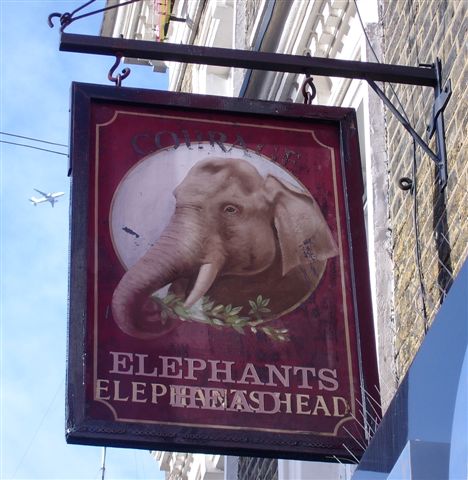 |
||
|
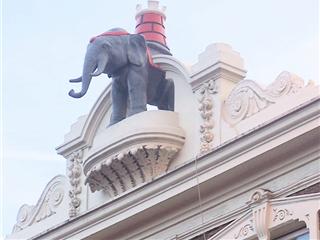 |
|
IMPORTS Elephant (and walrus) tusks were imported into London in large quantities. St Katherine's Docks (opened in 1828) included the 'Ivory House' a T-shaped building of 1858-60 (pictured). This warehouse, which also held convicts awaiting transportation to Australia, remains as part of the redevelopment of St Katherines. The large entrance for carts and waggons can still be seen and the gate pillars on East Smithfield are topped with elephants (see header). The East India Company's warehouses in Cutler Street stored ivory amongst their imports. Photographs in the collections of the Museum of London Docklands show warehouses of the London Docks stacked with tusks in the 1930s. In October 1947 20 baby elephants arrived from Ceylon on SS Arbratus and were unloaded at the George V Dock. They were destined for Tom Arnold's Christmas Circus in Harringay. |
WHITELEYS
William Whiteley came from Leeds to London in 1831 and inspired
by the Great Exhibition decided to open his own emporium. He
worked in a number of firms learning the drapery trade and saving
700 with which he opened his store in Westbourne Grove in 1863.
He expanded along the street and rebuilt after a fire in 1887.
Whiteleys advertised they could provide everything 'from a pin to
an elephant at short notice'! The present building was
constructed in 1911 on the site of the Paddington Baths. Whiteley
himself was shot by a man claiming to be his illegitimate son in
1907. The store was closed in 1981 but has reopened as a shopping
centre and cinema complex.
THOMAS GOODE
This fine shop selling china and crystal moved to its premises at
17-22 South Audley Street, Mayfair in 1845. There are two
splended china elephants in the shop windows standing over seven
feet high. They were produced by Minton for William Goode and
displayed at the Paris exhibitions of 1878 and 1889. [website]
LIBERTYS
The Liberty Store fronting Great Marlborough Street was designed
in a Tudor style in 1922-4. Some of the interior woodwork is made
from timbers salvaged from two of the last wooden sailing ships.
In the third floor carpet department a seated elephant is carved
on the panelling around the central atrium.
|
|
'TINKLING THE IVORIES'
This expression means playing the piano since the keys were made
from ivory in the past. Broadwoods had its main factory on a site
in Horseferry Road from 1858 to 1902, later occupied by the
Department of Transport.
CIRCUSES & SHOWS
Animals are rarely used now but in the past they were very
popular. John Kemble first introduced animals to the stage in
1788. In 1846 the City of London Theatre in Shoreditch borrowed
two elephants to appear in a play devised around the tricks they
performed. The theatrical collections of the V&A feature
elephants in performances. Guided tours available on a website
include one for the circus [click here].
THE ELEPHANT MAN
Joseph Merrick who had facial deformaties was known as the
Elephant Man and was treated by Frerick Treves at the Royal
London Hospital. Their museum has a display on this including
documents relating to his residence at the hospital. A BBC video
is shown 'QED: the true story of the Elephant Man'. The Museum is
housed in the basement of St Augustine with St Philip's Church in
Newark Street E1. It is generally open Monday to Friday 10-4:30
(not public holidays) but please check on 020 7737 7608 before
making a special journey. Admission is free but donations are
welcome. [website]
THE GREAT EXHIBITION
This was held in Hyde Park in a specially constructed building
during the summer of 1851. Exhibits were submitted from all over
the Empire and included a stuffed Indian elephant [pix].
|
ALBERT
MEMORIAL This was proposed in 1862 and finally completed in 1876. The overall design was by George Gilbert Scott but features numerous sculptures by other artists. The outer corners have representations of four continents (not Australia) and the 'Asia' group by JH Foley (who also designed the figure of Albert) includes an elephant [pix]. The memorial situated in Kensington Gardens, opposite the Royal Albert Hall, is now in the care of English Heritage. |
MUSEUMS & GALLERIES
The collections of the Natural History
Museum include elephants
and the V&A has objects made from ivory.
The National
Gallery has pictures
featuring elephants.
LORD GANESH
One of the Hindu deities depicted with four arms and an
elephant's head [more info]. The Shree Swaminarayan Mandir in
Brentfield Road NW10 is the largest Hindu temple outside India.
It is a magnificent building made from 5000 tonnes of carved
marble and limestone. Visitors are welcome and there is an
exhibition area. [website]
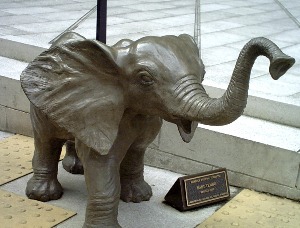 |
|
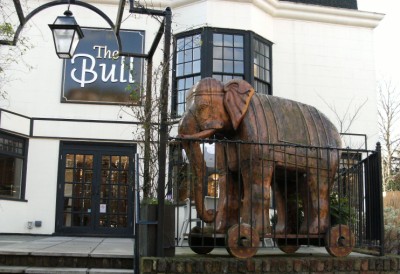 |
HIDDEN ELEPHANTS
There are some pillars with decorative tops at the western end of
Wapping High Street that remain from the London Docks. Do they
show elephants among the trees or are they just patterns? [pix]
Can you find an elephant on the London Underground map? If not
check it out on this website.
london-footprints.co.uk 2009
Resources
The London Encylopaedia by Weinreb & Hibbert
View information researched by Charles Dickens School with the
Guy Fox History Project [website]
Elephant & Castle 1948 &
2005 - a photography project with associated exhibition. Includes
resources for teachers (PDF Format). [website]
A collection of photographs of London elephants can be found on
this webpage